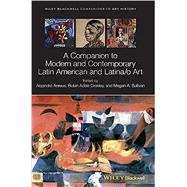In-depth scholarship on the central artists, movements, and themes of Latin American art, from the Mexican revolution to the present
A Companion to Modern and Contemporary Latin American and Latinx Art consists of over 30 never-before-published essays on the crucial historical and theoretical issues that have framed our understanding of art in Latin America. This book has a uniquely inclusive focus that includes both Spanish-speaking Caribbean and contemporary Latinx art in the United States. Influential critics of the 20th century are also covered, with an emphasis on their effect on the development of artistic movements.
By providing in-depth explorations of central artists and issues, alongside cross-references to illustrations in major textbooks, this volume provides an excellent complement to wider surveys of Latin American and Latinx art. Readers will engage with the latest scholarship on each of five distinct historical periods, plus broader theoretical and historical trends that continue to influence how we understand Latinx, Indigenous, and Latin American art today. The book’s areas of focus include:
- The development of avant-garde art in the urban centers of Latin America from 1910-1945
- The rise of abstraction during the Cold War and the internationalization of Latin American art from 1945-1959
- The influence of the political upheavals of the 1960s on art and art theory in Latin America
- The rise of conceptual art as a response to dictatorship and social violence in the 1970s and 1980s
- The contemporary era of neoliberalism and globalization in Latin American and Latino Art, 1990-2010
With its comprehensive approach and informative structure, A Companion to Modern and Contemporary Latin American and Latinx Art is an excellent resource for advanced students in Latin American culture and art. It is also a valuable reference for aspiring scholars in the field.








